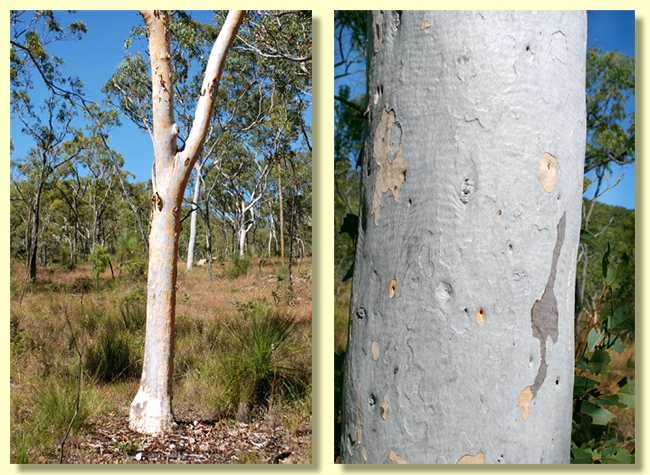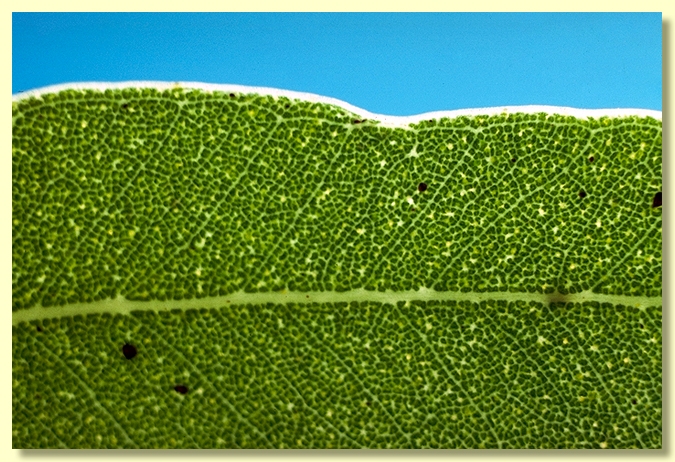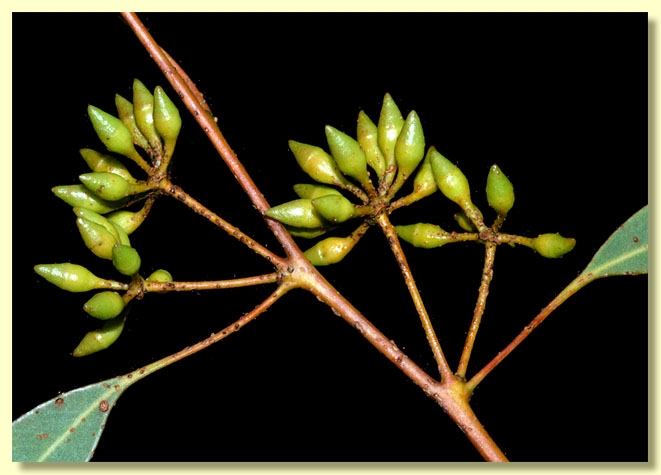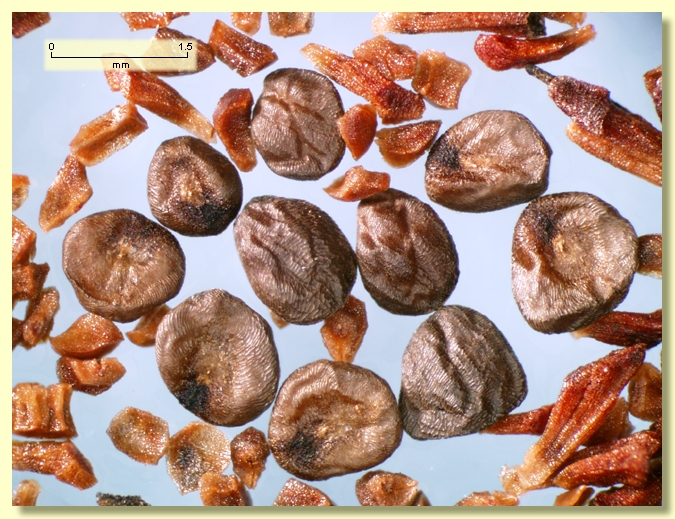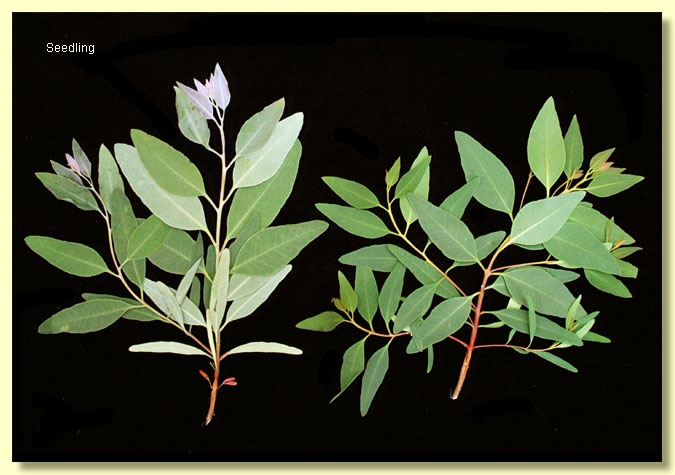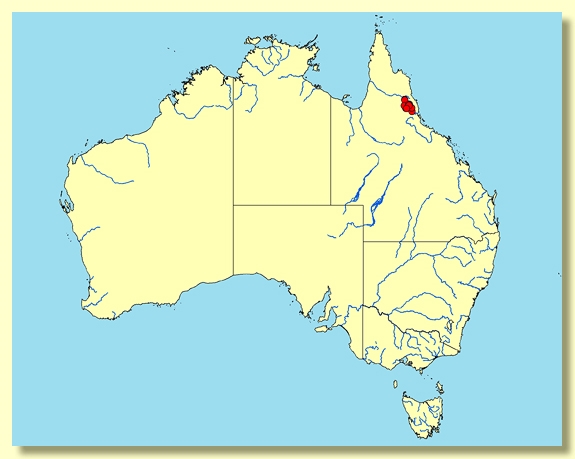Euclid - Online edition
Eucalyptus pachycalyx subsp. pachycalyx
Eucalyptus | Symphyomyrtus | Bisectae | Destitutae | Squamosae
Eucalyptus pachycalyx Maiden & Blakely, Crit. Revis. Eucalyptus 8: 15 (1929) subsp. pachycalyx
T: "A kind of Spotted Gum growing on the ranges at the back of Cairns, Queensland. Stunted trees, bluish bark with black spots." H.W.Mocatta, No. 13, December, 1915; holo: NSW.
Tree to 14 m tall. Forming a lignotuber.
Bark smooth throughout, mottled white, cream, pale grey with newly exposed bark yellow to creamy pink to bright orange; often powdery.
Juvenile growth (coppice or field seedlings to 50 cm): stem square to rounded in cross-section; juvenile leaves always petiolate, opposite for c. 5 pairs then alternate, broadly lanceolate to ovate, 8–15 cm long, 4–5.5 cm wide, green.
Adult leaves alternate, petiole 1–2.2(3) cm long; blade lanceolate to falcate, 6–17 cm long, 1.2–2.5 cm wide, base tapering to petiole, concolorous, dull, sometimes slightly glossy, green to blue-green, side-veins usually at an angle less than 45° to midrib, densely to very densely reticulate, intramarginal vein parallel to and remote from margin, oil glands few, intersectional or obscure.
Inflorescence commonly paired axillary, peduncles 0.8–2 cm long, buds 7, 9 or 11-flowered, pedicellate (pedicels 0.3–0.5 cm long). Mature buds ovoid (0.7–1.2 cm long, 0.4–0.6 cm wide), scar present, operculum conical, stamens irregularly flexed, anthers spherical, weakly versatile to adnate, basifixed, dehiscence slits separate, style long, stigma tapered, locules usually 3 or rarely 4, the placentae each with 4 vertical ovule rows. Flowers white.
Fruit pedicellate (0.3–0.5 cm long), cup-shaped or hemispherical, 0.4–0.6 cm long, 0.7–0.9 cm wide, disc raised-annular or level or descending, valves usually 3 or rarely 4, strongly exserted.
Seeds brown, 1.5–2 mm long, depressed-ovoid, dorsal surface smooth, hilum ventral.
Cultivated seedlings (measured at ca node 10): cotyledons Y-shaped (bisected); stem square in cross-section, non-glaucous or glaucous; leaves always petiolate, opposite for 4–8 pairs then becoming alternate, ovate to broadly lanceolate or elliptical, 5–8 cm long, 1.7–3.7 cm wide, base tapering to the petiole or sometimes rounded, apex acute or rounded, green, grey-green or slightly glaucous.
Flowering has been recorded in February.
Eucalyptus pachycalyx is a small tree species occurring in scattered localities in Queensland and subcoastal north-eastern New South Wales. It has white to grey smooth bark, with the newly exposed bark often bright orange to creamy-pink. It gets its common name from the blaze or cut surface of the bark which resembles, in colour and texture, the flesh of the popular Queensland blue pumpkin. It could be confused with no other species because of the paired umbels in the leaf axils. This character occurs also in the closely related, fully rough-barked tree E. squamosa.
Eucalyptus pachycalyx belongs in Eucalyptus subgenus Symphyomyrtus section Bisectae subsection Destitutae because the buds have two opercula, cotyledons are Y-shaped and branchlets lack oil glands in the pith. Within this largely Western Australian subsection, E. pachycalyx is further distinguished by its tree habit, the paired axillary inflorescences and its eastern Australian distribution. E. pachycalyx and E. squamosa together form the series Squamosae.
There are two subspecies:
E. pachycalyx subsp. pachycalyx is weakly separated from subsp. waajensis by having an operculum which is conical and longer than the hypanthium; fruit have 3, rarely 4, valves. It is restricted to northern Queensland being found in three locations: west of Herberton, north of Mt Garnet and at Mt Mulligan. An occurrence west of Mt Spec (fide Bernie Hyland, Atherton, Qld) requires confirmation with specimens.
E. pachycalyx subsp. waajensis differs from subsp. pachycalyx in having slightly shorter, more blunt opercula; some plants also have longer pedicels and fruit have 3 or 4 valves. This subspecies is sporadically distributed occurring in Queensland at Waaje in Barakula State Forest, near Eidsvold, Cracow and at Bull Creek Gorge between Springsure and Tambo, and in New South Wales in Banyabba Nature Reserve near Grafton. The latter locality is the only known locality in New South Wales. Plants at this site were described in 1997 as E. pachycalyx subsp. banyabba but the authors of EUCLID do not regard this as significantly different from subsp. waajensis, described in 1991. Specimens of subsp. banyabba have a marginally shorter operculum relative to the length of the hypanthium, and more noticably, slightly shorter pedicels and peduncles. Juvenile leaves are similar.
Eucalyptus pachycalyx subsp. banyabba is listed as "Endangered" under the Australian Government Environment Protection and Biodiversity Conservation Act 1999 (EPBC Act). Further information may be found at this web address:
http://www.environment.gov.au/cgi-bin/sprat/public/sprat.pl
Eucalyptus pachycalyx: Greek pachy-, thick and calyx, calyx, referring to the thick-walled fruit.



